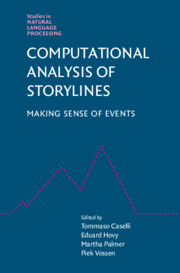Book contents
- Frontmatter
- Contents
- List of Contributors
- Introduction and Overview
- Part One Foundational Components of Storylines
- 1 The Role of Event-Based Representations and Reasoning in Language
- 2 The Rich Event Ontology: Ontological Hub for Event Representations
- 3 Decomposing Events and Storylines
- 4 Extracting and Aligning Timelines
- 5 Event Causality
- 6 A Narratology-Based Framework for Storyline Extraction
- Part Two Connecting the Dots: Resources, Tools, and Representations
- Author Index
1 - The Role of Event-Based Representations and Reasoning in Language
from Part One - Foundational Components of Storylines
Published online by Cambridge University Press: 06 November 2021
- Frontmatter
- Contents
- List of Contributors
- Introduction and Overview
- Part One Foundational Components of Storylines
- 1 The Role of Event-Based Representations and Reasoning in Language
- 2 The Rich Event Ontology: Ontological Hub for Event Representations
- 3 Decomposing Events and Storylines
- 4 Extracting and Aligning Timelines
- 5 Event Causality
- 6 A Narratology-Based Framework for Storyline Extraction
- Part Two Connecting the Dots: Resources, Tools, and Representations
- Author Index
Summary
This chapter reviews the research conducted on the representation of events, from theperspectives ofnatural language processing, artificial intelligence (AI), and linguistics. AI approaches to modeling change have traditionally focused on situations and state descriptions. Linguistic approaches start with the description of the propositional content of sentences (or natural language expressions generally). As a result, the focus in the two fields has been on different problems. I argue that these approaches have common elements that can be drawn on to view event semantics from a unifying perspective, where we can distinguish between the surface events denoted by verbal predicates and what I refer to as the latent event structure of a sentence. By clearly distinguishing between surface and latent event structures of sentences and texts, we move closer to a general computational theory of event structure, one permitting a common vocabularyfor events and the relations between them, while enabling reasoning at multiple levels of interpretation.
Information
- Type
- Chapter
- Information
- Computational Analysis of StorylinesMaking Sense of Events, pp. 23 - 46Publisher: Cambridge University PressPrint publication year: 2021
